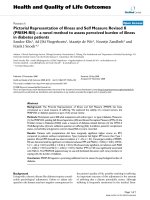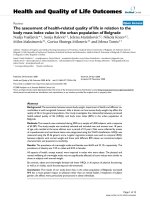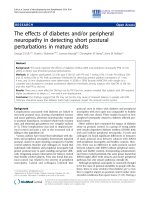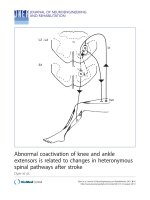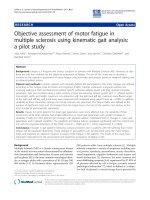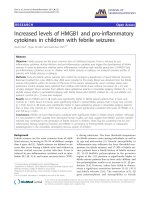Báo cáo hóa học: " Caregiver assessment of patients with advanced cancer: concordance with patients, effect of burden and positivity" ppt
Bạn đang xem bản rút gọn của tài liệu. Xem và tải ngay bản đầy đủ của tài liệu tại đây (503.07 KB, 8 trang )
BioMed Central
Page 1 of 8
(page number not for citation purposes)
Health and Quality of Life Outcomes
Open Access
Research
Caregiver assessment of patients with advanced cancer:
concordance with patients, effect of burden and positivity
Irene J Higginson* and Wei Gao
Address: King's College London, School of Medicine at Guy's, King's College and St Thomas' Hospitals, Department of Palliative Care, Policy and
Rehabilitation, Weston Education Centre, Cutcombe Road, London, SE5 9RJ, UK
Email: Irene J Higginson* - ; Wei Gao -
* Corresponding author
Abstract
Background: Clinicians and researchers often have to rely on information from caregivers to
assess patients with advanced cancer. This study aims to assess the validity (using patients'
assessment as the gold standard) of caregiver reports of patient concerns and the roles of caregiver
burden and positivity.
Methods: A total of 64 advanced cancer patient and informal caregiver dyads were recruited from
regional palliative care services and interviewed. Patients' outcomes were assessed with both the
patient and the caregiver version of the Palliative Outcome Scale (POS); caregiver burden and
positivity were collected with the Zarit Burden interview (ZBI) and three questions on
achievements and relationships. The agreement between patient- and caregiver-rated POS was
measured with weighted kappa statistics. The roles of caregiver burden and positivity in POS
agreement were studied with logistic regression controlling for potential confounders; adjusted
odds ratios were estimated from the models.
Results: Agreement was substantial for pain, moderate for four items, fair for three items and
slight for two items. Compared with patients self-ratings, caregivers described more problems with
information given and sharing feelings and were less likely to assess the patient felt their life was
worthwhile or felt good about themselves. Disagreement for three POS item ratings was
significantly associated with higher caregiver burden: "feeling anxious"(OR: 4.5; 95%CI: 1.3 to 15.6),
"life worthwhile"(OR: 12.4; 95%CI: 2.9 to 54.3) and "felt good" (OR: 7.7; 95%CI: 2.0 to 29.6).
Caregivers with higher positivity scores were more likely to agree patients' rating of "felt
good"(OR: 0.3; 95%CI: 0.1–0.9) but at increased risk of disagreeing about patient's "practical
problems"(OR: 4.2; 95%CI: 1.1 to 16.6).
Conclusion: Caregiver burden and positivity affect their assessments, especially of psychological
patient domains and whether patients assess their life as worthwhile. Awareness of this might help
clinicians and researchers better interpret caregiver assessments.
Published: 2 June 2008
Health and Quality of Life Outcomes 2008, 6:42 doi:10.1186/1477-7525-6-42
Received: 2 January 2008
Accepted: 2 June 2008
This article is available from: />© 2008 Higginson and Gao; licensee BioMed Central Ltd.
This is an Open Access article distributed under the terms of the Creative Commons Attribution License ( />),
which permits unrestricted use, distribution, and reproduction in any medium, provided the original work is properly cited.
Health and Quality of Life Outcomes 2008, 6:42 />Page 2 of 8
(page number not for citation purposes)
Background
In advanced cancer the assessment of pain, symptoms and
domains relevant to quality of life are an essential compo-
nent of quality care. In clinical practice, the oncologist
assesses the symptoms and factors affecting quality of life
in order to plan treatment. However, as the cancer
progresses it becomes more difficult for some patients to
directly provide assessments, because they are too weak,
or develop delirium [1]. Equally, in research, missing data
from patients who have become too ill to record assess-
ments or who have died become a serious problem[2,3].
In the absence of patient information, clinicians and
researchers often rely on the reports of caregivers, family
members and sometimes staff. Contemporary assess-
ments from lay caregivers (and family members) are often
reported as being closer to patient assessments than those
of staff. However, there is variance in the literature about
the extent to which caregivers agree with patients' self-rat-
ings [4-6]. Although many studies have assessed agree-
ment for symptoms and quality of life, few have examined
agreement regarding factors increasingly relevant at the
end of life, including psychological and spiritual concerns
[5-7]. Better understanding of what influences agreement
or disagreement between patients with advanced disease
and their caregivers would be useful, for clinicians and
researchers working among people with advanced cancer.
It would be especially important if family members
become decision makers, as is often the case in the termi-
nal stages of cancer [8].
Caregiver burden refers to people's emotional response to
the changes and demands of giving support to another.
Studies among elderly patients and those with dementia
have suggested that caregivers with higher levels of burden
tend to be less in agreement with patients' own ratings of
quality of life[6]. However, the burden of caregiving in
dementia and in nursing homes is different from that in
advanced cancer, where caregiving is intensive, but over a
shorter period than for dementia. Further, caregiver bur-
den is a concept that emphasizes the 'negative' compo-
nents of caregiving, rather than the positive elements,
which may be an important motivation for the car-
egiver[9]. There is increasing emphasis on resilience[5,9-
11] – of both patients and caregivers – and scales assessing
the positive aspects of caregiving have now begun to be
developed. It may be that just as greater caregiver burden
may reduce agreement, positivity of caregiving may
increase agreement. It is also possible that burden and
agreement are not strongly inversely correlated – as some
individuals may be highly burdened but also perceive
positive aspects of caregiving[12].
Understanding the roles of caregiver burden and positivity
in the agreement of patient and caregiver reported ratings
could help us to selectively use proxy assessment from car-
egivers and also effectively design intervention pro-
grams[6]. Therefore, we undertook a study: 1) to compare
the patient self-ratings with lay caregiver ratings using a
widely used palliative outcome scale (POS); 2) to deter-
mine whether the agreement was influenced by the level
of subjective burden and positivity of caregivers.
Methods
Design
cross-sectional ratings recorded by patients and, sepa-
rately, by their nearest lay caregiver or family member.
Setting
Six regional palliative care services in the south of England
(London and Chichester). Inclusion criteria were:
advanced cancer and receiving palliative care services,
either day care, home care, hospice, or hospital support
teams. The patients were part of a larger study assessing
the effectiveness of different models of palliative care serv-
ice[13,14]. Consenting patients identified their nearest
caregiver who, where possible, was also recruited, con-
sented and interviewed. Multi-centre ethics committee
approval was granted by the National Research Ethics
Service, South East Research Ethics Committee.
Data Collection
data was collected between 2000 and 2002 using trained
interviewers, usually meeting consenting patients and car-
egivers, in their own homes, who were interviewed sepa-
rately. Clinical and demographic data of patients and
caregivers were collected. Patients' general health status
was measured by using an item from Euro QoL-5D on a
visual analogue scale (0–100)[15]. In addition, patients
and caregivers separately completed the Palliative Out-
come Scale (POS)[14,16]. POS was developed from exten-
sive review of the literature and testing with both users
(patients and caregivers from a range of cultures) and cli-
nicians[16]. Independent validation of POS found it can
usefully reflect practice in both inpatient palliative care
settings and nursing homes[17,18]. The scale does not
function to record one single underlying construct "qual-
ity of life" but it reflects the main components enshrined
by Dame Cicely Saunders in the concept of "total pain"
including pain and other symptoms, emotional, social,
spiritual/existential and communication/information
components[14]. The effect of each item on the daily life
of the individual over the last three days is scored on a 5-
point Likert scale ranging from 0 (not at all) to 4 (over-
whelmingly). For example, "over the last three days have
you been feeling anxious or worried about your illness or
treatment?" The patient version of POS directly asked the
patient about their symptoms and information needs
whereas the caregiver version asked the caregiver to assess
Health and Quality of Life Outcomes 2008, 6:42 />Page 3 of 8
(page number not for citation purposes)
their view of the patients' circumstances. Details of scales
are shown in the appendix.
In addition, caregivers self-reported demographic infor-
mation and completed the Zarit Burden Interview (ZBI), a
22 item, 5-point Likert scale (never = 0, nearly always = 4)
used widely to assess caregiver burden[19,20]. The total
burden was obtained by adding the scores for all items
with a range of 0 to 88, higher scores indicating greater
burden. Positivity was evaluated using three 5-point Likert
scale questions about the positivity of caregiving ("Do
you feel a sense of achievement caring for your relative";
"Do you feel that you have developed a closer relationship
with your relative since you have been caring for him/
her?"; "Has caring for your relative altered your ideas
about what is important in life?"). These are based on the
stress-appraisal-coping model of Lazarus et al[21], the
Lawton scale[22] and questions used in a survey of almost
1000 caregivers in Australia[11]. Combined they give a
total score ranging from 0 to 12 with a higher score indi-
cating a more positive view.
Analysis
Mean and median score of patient- and caregiver-rated
POS were calculated for each individual item. Due to the
non-normal distribution of data, the Wilcoxon signed-
rank test was used to test for differences between patients
and caregivers. Internal consistency of the scale was
explored using Cronbach's alpha, although we hypothe-
sised that values for POS would not be high, because POS
does not measure one underlying construct. The agree-
ment between patient and caregiver dyads was assessed
using Cicchetti-Allison type weighted Kappa [23] in con-
junction with the percentage agreement (the percentage of
cases for which patient and caregiver agree), as Kappa may
be low even when there are high levels of agreement if
there is prevalence bias (i.e. many scores are one
value)[24]. Kappa tests for agreement controlling for
chance agreement and its values were considered as fol-
lows: slight (0.0–0.2), fair (0.21–0.40), moderate (0.41–
0.60), substantial (0.61–0.80) and perfect agreement
(>0.80)[25].
The associations between POS agreement and informal
caregiver burden and positivity were evaluated using mul-
tiple logistic regression. The dependent variable was an
indicator of agreement for which 0 and 1 respectively
denoted 'agree' (where caregiver and patient ratings were
identical) and 'disagree'. Five variables (patient: cancer
site; caregiver: age, gender, relationship to patient, living
status) which had statistical significance (by bivariate
tests) and/or clinical/biological relevance were included
in the models to control for their potential effects[6,26].
Scores of caregiver burden and positivity were dichot-
omized as 0 and 1 (with median score as the cutoff). We
chose to dichotomize the scores using median because: 1)
dichotomized scores provided the best fit compared to the
other types of scores (e.g. original, trichotomized); 2)
median (comparing to lower and upper quartile) dichot-
omized scores provided the best power[27,28]. We tested
the relationship between caregiver burden and positivity
using Spearman correlation. But we could not be sure that
in reality there was no colinearity between burden and
positivity because of the conflicting findings from prior
studies[9,29,30] and the limitations of our sample size. So
caregiver burden and positivity were assessed separately
using multivariate models regardless of the results of
bivaraite analysis. Adjusted odds ratios (OR) and their
95% confidence interval (95%CI) of the higher vs. lower
caregiver burden or positivity were then estimated from
the models to quantify the strength of associations. Unad-
justed ORs were also reported for comparison purposes.
We conducted two sensitivity analyses. First we varied the
cut-off for agreement so that differences less than or equal
to 1 score denoted 'agree' and disagreement beyond this
denoted 'disagree'. Second, we also varied the dichotomi-
zation point of caregiver burden scores and the caregiver
positivity scores to the first and then the third quartiles,
i.e. selecting only the least or most burdened and the least
or most positive caregivers. All tests were two-sided and a
P-value < 0.05 was considered statistically significant.
Analyses were conducted using SAS version 9.1.3 (SAS
Institute, Cary, NC).
Results
A total of 64 patient and caregiver dyads were recruited
and interviewed. Around two-thirds of the patients were
male and two-thirds of the caregivers were female. Median
age of patients and caregivers was between 74 and 72
years, with caregivers being slightly younger. In this group
nearly all caregivers were spouses or partners and nearly
all caregivers lived with the patient. Only 10 of the car-
egivers were working outside the home (see table 1). Table
1 also lists the descriptive statistics of total ZBI and posi-
tivity scores in the study population. The scales of burden
and positivity showed high internal consistency (Cron-
bach's alpha: 0.85 for ZBI and 0.82 for positivity).
Table 2 presents the item-specific mean, median scales of
the patient self-rated POS and the caregiver-rated POS,
and the respective Cronbach alphas for patient- and car-
egiver-rated POS. Two phenomena emerged. First, the
internal consistency, as tested by Cronbach's alpha, for
patient's and caregiver's POS are both modest, suggesting
that POS is a scale which does not reflect a single underly-
ing construct but a number of constructs, as in the original
development. Second, mean and median scores are very
similar between patients and caregivers for six out of 10
items – pain, other symptoms, patient anxiety, family anx-
iety, wasted time, and practical problems. For four items
Health and Quality of Life Outcomes 2008, 6:42 />Page 4 of 8
(page number not for citation purposes)
the caregivers ratings described more problems than did
patients: information given, sharing feeling, whether life
felt worthwhile, and whether the patient felt good about
themselves as a person. Caregivers reported a slightly
higher (i.e. worse) and statistically significant (S = 413, p
< 0.001) median total POS score than patients.
Table 1: Demographic and clinical characteristics statistics for advanced cancer patients and their caregivers
Variable Patient n (%)* Caregiver n (%)*
Total 64 64
Gender
Male 45 (70.3) 18 (28.1)
Female 19 (29.7) 46 (71.9)
Median age (min, max) 73.8 (50, 88) 67.9 (50, 85)
Mean age (sd, 95% CI) 71.6 (9.1, 69.3–73.8) 69.7 (7.4, 67.9 -71.6)
Relationship of caregiver to patient
Spouse/Partner - 58 (90.6)
Parent - 1 (1.6)
Child - 3 (4.7)
Others - 2 (3.1)
Who does the patient live with?
Lives with spouse 57 (89.1) -
Lives alone 1 (1.6) -
Lives with family 5 (7.8) -
Not known 1 (1.6) -
Employment
Not working outside the home 52 (81.3) 44 (68.8)
Unable to work/Stop working to care 8 (12.5) 1 (1.6)
Working outside the home 3 (4.7) 10 (15.6)
Other 1 (1.6) 9(14.1)
Ethnicity
White 64 (100.0) 59 (92.2)
Other 0 (0.0) 5 (7.8)
Primary cancer site
Lung 11 (17.2) -
Gynea/Breast 7 (10.9) -
GU/Prostate 14 (21.9) -
Gastrointestinal 16 (25.0) -
Other 16 (25.0) -
General health status (Euro QoL 5D, 0–100 (best))
Mean (SD) 61.5 (17.4)
Median(min, max) 60 (12, 99)
Zarit total burden score (0–88 (worst))
Mean (SD) - 18.5 (11.0)
Median (min, max) - 17 (0, 60)
Cronbach's alpha - 0.85
Positivity total score (0–12 (best))
Mean (SD) - 6.4 (4.0)
Median (min, max) - 6.0(0, 12)
Cronbach's alpha - 0.82
*Unless indicated
Health and Quality of Life Outcomes 2008, 6:42 />Page 5 of 8
(page number not for citation purposes)
When we tested for agreement (using weighted Kappa)
between patients and caregivers, we found agreement to
be substantial for pain, moderate for four items (other
symptoms, feeling anxious, family anxious and share feel-
ing), fair for three items (life worthwhile, felt good and
time wasted), and slight for two items (information given
and practical problems). However, agreement for three of
the items: information, time wasted and practical prob-
lems, should be interpreted cautiously, since the high
level of percentage agreement for these items (71.9%,
95.3% and 76.6%) signaled that the weighted Kappa sta-
tistics may be affected by prevalence bias and thus under-
estimate the true agreement.
There was no significant correlation between caregiver
burden and positivity (Rho = -0.16, p = 0.21), nor
between total POS score and caregiver burden (Rho =
0.10, p = 0.45) or positivity (Rho = -0.08, P = 0.52). The
disagreement between caregivers and patients over three
POS items was significantly associated with caregiver bur-
den (Table 3). Disagreement on three POS items were
more likely to occur among caregivers with higher burden:
"feeling anxious" (OR= 4.50; 95%CI: 1.30 to 15.59; P =
0.018), "life worthwhile"(OR = 12.43; 95%CI: 2.85 to
54.27; P = 0.001) and "felt good"(OR = 7.73; 95%CI: 2.02
to 29.60; P = 0.003). Caregivers with more positivity had
higher agreement with the patients on "felt good" (OR =
0.27; 95% CI: 0.08 to 0.86; P = 0.027) than those with less
positivity but were more likely to disagree (OR = 4.22;
95% CI: 1.08 to 16.55; P = 0.039) with patients for the
POS item "practical problems". The two sensitivity analy-
sis produced similar results, both varying cutoff for agree-
ment and for burden and positivity, although some
results were non-significant because of the smaller num-
bers. Unadjusted odds ratios also identified these associa-
tions, but they tended to underestimate the effects of
caregiver burden and positivity on POS agreement.
Multiple logistic regression analyses also indicated that
agreement on "share feeling" was lower where caregiver
was older (OR = 1.16, 95% CI: 1.04 to 1.29, P = 0.007 in
caregiver burden model and OR = 1.17, 95%CI: 1.05 to
1.30, P = 0.006 in positivity model for every one year
increase respectively); female gender was associated with
increased risk of disagreement for "pain" (OR = 1.97,
95%CI: 0.12 to 3.81, P = 0.036 in caregiver burden model
and OR = 1.77, 95%CI: 0.04 to 3.50, P = 0.046 in positiv-
ity model) and "family anxious"(OR = 2.81, 95%CI: 0.74
to 4.88, P = 0.008 in caregiver burden model and OR =
2.95, 95%CI: 0.88 to 5.02, P = 0.005 in positivity model).
The other factors had no significant independent impact
on agreement.
Discussion
This study examined the validity of caregiver responses
when compared to advanced cancer patients self ratings. It
explored whether the caregiver burden and positivity are
associated with agreement between the caregiver and
patient ratings. Three key findings emerged. First, overall
caregivers in our study showed substantial agreement with
patients for pain, and moderate to fair agreement for
seven out of nine other items of our scale, POS. Our levels
of percentage agreement were similar to those between cli-
nician and cancer patient self-ratings when assessing
symptoms[31], where the levels of disagreement did not
affect treatment decisions. Therefore our results suggest
that contemporary caregiver assessments are reasonably
valid and reliable compared to patients self assessments,
at least using the scale in this study, POS. POS could be
completed by caregivers to give an assessment of patient
Table 2: Mean and median score for patients (n = 64) and caregivers (n = 64), weighted kappa and percentage agreement between
patients and caregivers by POS items
POS item Patients Caregivers Agreement
mean(SD) Median (min, max) mean (SD) Median (min, max) Weighted Kappa (95%CI) Percentage agreement(%)
Pain 1.4(1.1) 1(0,4) 1.3(1.0) 1(0,4) 0.69(0.54–0.83) 53.1
Other symptoms 1.2(1.1) 1(0,4) 1.2(1.1) 1(0,4) 0.51(0.31–0.71) 54.7
Feeling anxious 1.0(1.2) 0(0,4) 1.0(1.0) 1(0,4) 0.44(0.20–0.67) 50.0
Family anxious 1.8(1.3) 2(0,4) 1.6(1.2) 1(0,4) 0.49(0.30–0.68) 37.5
Information given* 0.2(0.8) 0(0,4) 0.9(1.6) 0(0,4) 0.04(-0.10–0.17) 71.9
Share feeling* 0.6(1.2) 0(0,4) 1.0(1.3) 1(0,4) 0.48(0.26–0.71) 51.6
Life worthwhile** 0.5(0.8) 0(0,4) 0.9(1.0) 1(0,4) 0.31(0.03–0.58) 48.4
Felt good** 1.0(1.1) 1(0,4) 1.5(1.2) 1(0,4) 0.35(0.12–0.58) 39.1
Waste of time 0.1(0.4) 0(0,2) 0.1(0.4) 0(0,2) 0.38(-0.18–0.93) 95.3
Practical problems 0.5(1.0) 0(0,4) 0.7(1.3) 0(0,4) 0.20(-0.04–0.45) 76.6
Total** 8.2(4.4) 8(0,22) 10.2(5.1) 9(0,26)
Cronbach alpha 0.49 0.55
Significant difference between patient- and caregiver-ratings is labeled with *, *p < 0.01; **p < 0.001. p < 0.05 is considered statistically significant.
Health and Quality of Life Outcomes 2008, 6:42 />Page 6 of 8
(page number not for citation purposes)
concerns in clinical practice and in research, if patients are
likely to become unable to make assessments. Our find-
ings differ from other research, which has suggested car-
egivers rate pain and symptoms more severely than
patients [32-34]. It may be that at this stage of illness car-
egivers agree more with patients self ratings, or that the
higher validity we found may be a feature of POS, which
uses more detailed definitions of severity and effect on the
person, than the terms mild, moderate, severe, used in
many scales.
Second, agreement was lowest for the more personal and
psychological items such as: whether 'life was worth-
while', whether 'feelings could be shared' and whether the
patient 'felt good about themselves', where caregivers
recorded more problems than did the patients. It is inter-
esting to note that caregivers were less likely to say patient
felt their life was worthwhile than did patient's self rat-
ings. When clinicians are discussing end of life treatment
options with caregivers[13], they should be aware that
caregivers may rate the life of the patient as less worth-
while than the patient themselves. Our results raise con-
cerns about the use of caregivers as proxies when there are
problems with a patient's mental capacity, and also for
those who are promoting assisted suicide by caregivers.
Third, for these aspects (and also for assessments of
patient anxiety), caregivers were more likely to disagree
with the patient self-rating when caregiver burden was
higher. Assessments of how 'anxious' the patient, "life
worthwhile" and "feeling good about self" were affected
by total burden. Therefore, caregivers in much burdened
circumstances may be prone to assess certain patient situ-
ations unreliably. Our findings support the work of Sands
et al. [35] which found that higher caregiver burden was
associated with discrepancies in ratings of quality of life;
our data showed a similar pattern among cancer patients
and their caregivers. However, our data suggest that it is
the psychological components of quality of life, rather
than symptoms, that are least reliable and most influ-
enced by burden. Conversely, positivity was associated
with improved agreement on whether the patient's life
was worthwhile. However, surprisingly less burdened car-
egivers were less likely to agree about patients' practical
needs. This finding could make sense clinically, in that
less burdened caregivers may be less in touch with
patients and less aware of their practical needs. These
results would need to be confirmed in future studies.
Finally, the total burden scores were not very high in this
sample. When developing the measure Zarit defined less
than 21 as low burden, higher than our mean (median)
score of 18.5 (17)[19,20]. This is a surprising finding, as
this was a sample of terminally patients, most of whom
died within the next few weeks and months. All of the
patients and caregivers in our study were receiving sup-
port from specialist palliative care services, including
multi-professional home care teams. Systematic reviews
have suggested that these teams relieve patient symptoms
and support caregivers[36]. The finding of relatively low
caregiver burden in our sample supports these studies.
However it may also be that the Zarit measure of burden,
which was developed initially to study the caregivers of
people with dementia[19], misses some important
aspects of burden in cancer, especially in palliative care
settings. We plan, therefore, to undertake further work to
understand caregiver burden in cancer, the best way to
measure it, what are the best services and methods of sup-
port to help caregivers. These results suggest that if clini-
cians or researchers do rely on caregiver assessments as a
proxy for patient concerns they should also measure car-
Table 3: Adjusted odds ratios (95%CI) and unadjusted odds ratios (95%CI) of caregiver rating not equal to patient on the palliative
outcomes of advanced cancer patients, caregivers with higher compared to lower scores of ZBI/positivity, results were derived from
logistic regression models and adjusted or not adjusted for primary cancer site, caregiver age, caregiver sex, relationship to patient,
patient living status and caregiver employment status (N = 64).
Question Burden (higher vs lower) Positivity (higher vs lower)
Adjusted-OR (95%CI) Unadjusted-OR (95%) Adjusted-OR* (95%CI) Unadjusted-OR (95%CI)
Pain 0.53(0.14–2.02) 0.88(0.33 to 2.34) 1.80(0.52–6.23) 1.63 (0.61 to 4.40)
Other symptoms 0.53(0.16–1.78) 0.59(0.22 to 1.61) 2.38(0.71–8.02) 1.43(0.53 to 3.84)
Feeling anxious 4.50(1.30–15.59)* 3.18 (1.15 to 8.84)* 2.22(0.72–6.90) 1.29(0.48 to 3.44)
Family anxious 1.63(0.47–5.62) 2.04 (0.72 to 5.73) 1.14(0.34–3.86) 0.82(0.30 to 2.26)
Information given 1.99(0.58–6.91) 2.04 (0.67 to 6.21) 0.40(0.11–1.45) 0.46(0.15 to 1.43)
Share feeling 1.46(0.41–5.25) 1.00 (0.37 to 2.66) 2.50(0.65–9.53) 1.45(0.54 to 3.88)
Life worthwhile 12.43(2.85–54.27)** 6.61 (2.21 to 19.76)** 0.95(0.32–2.82) 0.89(0.33 to 2.37)
Felt good as a person 7.73(2.02–29.60)** 5.65(1.83 to 17.46)** 0.27(0.08–0.86)* 0.32(0.11 to 0.90)*
Practical problems 0.46(0.12–1.79) 0.64(0.20 to 2.07) 4.22(1.08–16.55)* 2.90(0.86 to 9.78)
Note: An odds ratio of greater than 1 indicates that disagreement was more likely when caregivers had higher burden or more positivity (median
score as the cutoff). The modeled probability was the caregiver disagrees with patient's rating on palliative outcomes.
*p < 0.05, **p < 0.01; p < 0.05 is considered statistically significant.
Health and Quality of Life Outcomes 2008, 6:42 />Page 7 of 8
(page number not for citation purposes)
egiver burden and may need to adjust for differences and
disagreement.
Our study has some limitations, the most important of
which is the number of confounding variables that we
could adjust for. We were limited here by the sample size
(although our study was large compared to many which
include terminally ill patients and caregivers and powered
to detect an OR about 3.0) and the range of variables col-
lected. Ideally we would have liked to adjust for the dura-
tion of care and broader sociodemographic variables such
as educational level and culture[10]. The quality of the
relationship between patients and caregivers may also
have been very important. Nevertheless we were able to
adjust for basic variables including cancer site, gender,
age, relationship to patient and whether the patient lived
alone or not. Interestingly, gender appeared to have some
effect, with women caregivers showing higher disagree-
ment with patient self-ratings for the items 'pain' and
'family anxiety'. However, there were many more women
than men caregivers in our sample, so this result should
be interpreted with caution. For older patients there was
also more disagreement on whether patients were able to
share feelings. It may be that older patients are less likely
to discuss how they are feeling and so making it difficult
for their caregivers to assess this aspect of care[37]. A fur-
ther problem with the study was that we had to dichot-
omize caregiver burden into high and low. Nevertheless,
our sensitivity analysis, using a different cut off point of
high/low burden supported these results. We should bear
in mind that the nature of the data (ordinal, non-paramet-
ric) and the sample size would not allow us to divide the
data into quartiles or quintiles. It may be that our analysis
diluted the effect of burden, and the true effect is larger.
However, our data suggests hypotheses that can be tested
in larger studies. Due to the data limitations, we could not
examine in further detail how the perceived burden direc-
tionally affects the agreement, but our results raise alarm
for items such as "life worthwhile" and "feeling good", for
which disagreement is more likely to occur when caregiv-
ers have relatively high burden or less positivity.
Conclusion
Caregiver burden and positivity influence caregivers'
assessments. We may need to adjust for differences and
disagreement when using caregiver assessment as a proxy
for patients' concerns. Caregivers' assessments of psycho-
logical aspects, especially whether patient's consider their
life is worthwhile, may be least valid.
Competing interests
The authors declare that they have no competing interests.
Authors' contributions
Professor IH is the principal investigator and oversaw the
whole project, IH is responsible for the completeness and
accuracy of the data. Data analyses were co-designed by
listed authors and performed by WG, The manuscript was
drafted by IH with inputs from WG Both authors
approved the final version, IH is the guarantor of the
whole study.
Appendix: Palliative outcome scale
[Additional file 1]
Additional material
Acknowledgements
We thank the patients and caregivers who took part in the study, staff and
volunteers at the six day hospice and associated palliative care services who
recruited and interviewed patients and caregivers, Danielle Goodwin and
other interviewers in the study, the NHS Executive (London and South
East) who funded the original study. Dr Wei Gao is supported by the
National Cancer Research Institute, UK, a part of the "COMPlex interven-
tions: Assessment, trialS and implementation of Services in Supportive and
Palliative Care (COMPASS)" collaborative. We thank Professors Peter Fay-
ers, Gordon Murray, Julia Brown and Dr Bee Wee for their helpful com-
ments to improve this manuscript and Dr Diana Jackson for her help and
insightful discussions about caregiver burden and positivity.
References
1. Solano JP, Gomes B, Higginson IJ: A comparison of symptom
prevalence in far advanced cancer, AIDS, heart disease,
chronic obstructive pulmonary disease and renal disease. J
Pain Symptom Manage 2006, 31:58-69.
2. Ingleton C, Faulkner A: Quality assurance in palliative care:
some of the problems. Eur J Cancer Care (Engl ) 1995, 4:38-44.
3. Diehr P, Johnson LL: Accounting for missing data in end-of-life
research. J Palliat Med 2005, 8 Suppl 1:S50-S57.
4. Mittal V, Rosen J, Govind R, Degenholtz H, Shingala S, Hulland S, Rhee
Y, Kastango KB, Mulsant BH, Castle N, Rubin FH, Nace D: Percep-
tion gap in quality-of-life ratings: an empirical investigation
of nursing home residents and caregivers. Gerontologist 2007,
47:159-168.
5. Sprangers MAG, Aaronson NK: The role of health care providers
and significant others in evaluating the quality of life of
patients with chronic disease: a review. J Clin Epidemiol 1992,
45:743-760.
6. Tang ST, McCorkle R: Use of family proxies in quality of life
research for cancer patients at the end of life: a literature
review. Cancer Invest 2002, 20:1086-1104.
7. Torti FM Jr., Gwyther LP, Reed SD, Friedman JY, Schulman KA: A
multinational review of recent trends and reports in demen-
tia caregiver burden. Alzheimer Dis Assoc Disord 2004, 18:99-109.
8. Kissane DW: The challenge of discrepancies in values among
physicians, patients, and family members. Cancer 2004,
100:1771-1775.
Additional file 1
Palliative Outcome Scale. The file provided the original questionnaire
used in this manuscript for assessing palliative outcomes.
Click here for file
[ />7525-6-42-S1.doc]
Publish with BioMed Central and every
scientist can read your work free of charge
"BioMed Central will be the most significant development for
disseminating the results of biomedical research in our lifetime."
Sir Paul Nurse, Cancer Research UK
Your research papers will be:
available free of charge to the entire biomedical community
peer reviewed and published immediately upon acceptance
cited in PubMed and archived on PubMed Central
yours — you keep the copyright
Submit your manuscript here:
/>BioMedcentral
Health and Quality of Life Outcomes 2008, 6:42 />Page 8 of 8
(page number not for citation purposes)
9. Zarit SH, Robertson SM: Positive dimensions of mental health.
Aging Ment Health 2006, 10:437-438.
10. Pinquart M, Sorensen S: Associations of stressors and uplifts of
caregiving with caregiver burden and depressive mood: a
meta-analysis. J Gerontol B Psychol Sci Soc Sci 2003, 58(2):112-128.
11. Schofield HL, Murphy B, Herrman HE, Bloch S, Singh B: Family car-
egiving: measurement of emotional well-being and various
aspects of the caregiving role. Psychol Med 1997, 27:647-657.
12. Reich JW, Zautra AJ, Davis M: Dimensions of affect relation-
ships: Models and their integrative implications. Reviews of
General Psychology 2003, 7:66-83.
13. Goodwin DM, Higginson IJ, Myers K, Douglas HR, Normand CE:
Effectiveness of palliative day care in improving pain, symp-
tom control, and quality of life. J Pain Symptom Manage 2003,
25:202-212.
14. Higginson IJ, Donaldson N: Relationship between three pallia-
tive care outcome scales. Health and Quality of Life Outcomes 2004,
2:68-75.
15. Kind P, Dolan P, Gudex C, Williams A: Variations in population
health status: results from a United Kingdom national ques-
tionnaire survey. BMJ 1998, 316:736-741.
16. Hearn J, Higginson IJ: Development and validation of a core out-
come measure for palliative care: the palliative care out-
come scale. Qual Health Care 1999, 8:219-227.
17. Brandt HE, Deliens L, van der Steen JT, Ooms ME, Ribbe MW, van
der Wal G: The last days of life of nursing home patients with
and without dementia assessed with the Palliative care Out-
come Scale. Palliat Med 2005, 19:334-342.
18. Stevens AM, Gwilliam B, A'Hern R, Broadley K, Hardy J: Experience
in the use of the palliative care outcome scale. Support Care
Cancer 2005, 13:1027-1034.
19. Zarit SH, Reever KE, Bach-Peterson J: Relatives of the impaired
elderly: correlates of feelings of burden.
Gerontologist 1980,
20:649-655.
20. Zarit SH, Orr RD, Zarit JM: The Hidden Victims of Alzheimer's Disease:
Families Under Stress New York, New York University Press; 1985.
21. Lazarus RS, Folkman S: Stress, Appraisal, and Coping Springer; 1984.
22. Lawton MP, Kleban MH, Moss M, Rovine M, Glicksman A: Measur-
ing caregiving appraisal. J Gerontol 1989, 44(3):61-71.
23. Cicchetti DV, Allison T: A New Procedure for Assessing Relia-
bility of Scoring EEG Sleep Recordings. American Journal of EEG
Technology 1971:101-109.
24. Byrt T, Bishop J, Carlin JB: Bias, prevalence and kappa. J Clin Epi-
demiol 1993, 46:423-429.
25. Landis JR, Koch GG: The measurement of observer agreement
for categorical data. Biometrics 1977, 33:159-174.
26. Greenland S: Modeling and variable selection in epidemiologic
analysis. Am J Public Health 1989, 79:340-349.
27. Coen RF, O'Boyle CA, Coakley D, Lawlor BA: Individual quality of
life factors distinguishing low-burden and high-burden car-
egivers of dementia patients. Dement Geriatr Cogn Disord 2002,
13(3):164-170.
28. Resnizky S, Bentur N: Can family caregivers of terminally ill
patients be a reliable source of information about the sever-
ity of patient symptoms? Am J Hosp Palliat Care 2006, 23:447-456.
29. Albinsson L, Strang P: Existential concerns of families of late-
stage dementia patients: questions of freedom, choices, iso-
lation, death, and meaning. J Palliat Med 2003, 6:225-235.
30. Hunt CK: Concepts in caregiver research. J Nurs Scholarsh 2003,
35:27-32.
31. Basch E, Iasonos A, McDonough T, Barz A, Culkin A, Kris MG, Scher
HI, Schrag D: Patient versus clinician symptom reporting using
the National Cancer Institute Common Terminology Crite-
ria for Adverse Events: results of a questionnaire-based
study. Lancet Oncol 2006, 7:
903-909.
32. Higginson IJ, McCarthy M: Validity of the support team assess-
ment schedule: do staffs' ratings reflect those made by
patients or their families? Palliat Med 1993, 7:219-228.
33. McPherson CJ, Wilson KG, Lobchuk MM, Brajtman S: Family car-
egivers' assessment of symptoms in patients with advanced
cancer: concordance with patients and factors affecting
accuracy. J Pain Symptom Manage 2008, 35:70-82.
34. Siminoff LA, Rose JH, Zhang A, Zyzanski SJ: Measuring discord in
treatment decision-making; progress toward development
of a cancer communication and decision-making assessment
tool. Psychooncology 2006, 15:528-540.
35. Sands LP, Ferreira P, Stewart AL, Brod M, Yaffe K: What explains
differences between dementia patients' and their caregivers'
ratings of patients' quality of life? Am J Geriatr Psychiatry 2004,
12:272-280.
36. Higginson IJ, Finlay IG, Goodwin DM, Hood K, Edwards AG, Cook A,
Douglas HR, Normand CE: Is there evidence that palliative care
teams alter end-of-life experiences of patients and their car-
egivers? J Pain Symptom Manage 2003, 25:150-168.
37. Jansen J, van WJ, van DS, Heeren T, Bensing J: Patient education
about treatment in cancer care: an overview of the litera-
ture on older patients' needs. Cancer Nurs 2007, 30:251-260.

